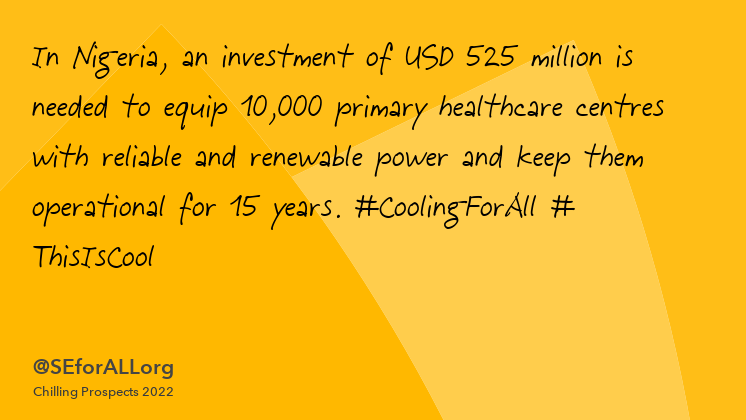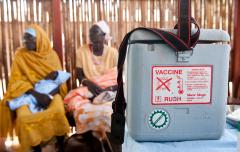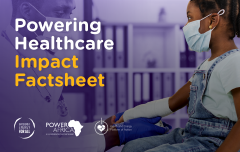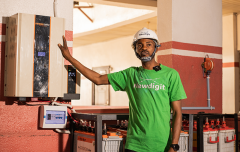Chilling Prospects 2022: Advancing health facility electrification
 |
Reflections on five years of the Kigali Amendment by SEforALL's Powering Healthcare programme |
The COVID-19 pandemic has emphasized the importance of reliable power for health service delivery and has led to increased momentum in global interest to address the challenges that surround health facility electrification. While decentralized renewable energy solutions present an opportunity to deploy efficient solutions in a rapid and cost-effective way, barriers such as the availability of reliable data, long-term sustainability and innovative financing mechanisms, and effective coordination remain. In response to the COVID-19 pandemic and the resulting investment need for the health sector, SEforALL continues to leverage its longstanding Powering Healthcare programme to work with governments and their development partners to build the evidence and solutions needed to achieve universal electrification of health facilities by 2030.
Measuring the impact of health facility electrification
Electricity is generally understood as a prerequisite to almost all aspects of a well-functioning health facility, but it is often difficult to measure or quantify the direct impact of electricity on health outcomes due to its many determinants and contextual factors. Therefore, impact is often measured indirectly through the lens of a specific aspect of health services, which can include service delivery, preventative care, vaccine storage and delivery, maternal health, and health-seeking behaviour. These pathways are examined in SEforALL’s recently launched Powering Healthcare Impact Factsheet, which compiles existing, published studies on the linkages between reliable power at health facilities and improved health outcomes.
While there are still several gaps in better understanding and specifically in quantifying the impact of reliable energy on health outcomes, the available research supports the importance of reliable power in the health sector. For example, a study in India found that primary healthcare centres without access to electricity had 64 percent less deliveries, 39 percent less in-patients, and 38 percent less out-patients. [1] Another study in Zambia found the acquisition of solar-powered microscopes led to a 25–30 percent increase in the number of people tested for tuberculosis (TB), contributing towards the increase in the TB cure rate from 62 percent to 72 percent in the area. [2]
Women are also disproportionately affected by low levels of electricity access, with a study in Uganda revealing that electricity had the second highest protective effect on maternity health after availability of midwives, reducing the case fatality rate by 61 percent. [3] While these data points provide a general understanding of the importance of reliable energy in a health facility setting, additional investment in impact data can allow the sector to better understand and quantify the impact that reliable power can have on health service delivery and health outcomes.
Taking stock of global efforts
To gain a better understanding of global progress and identify potential opportunities for coordination, SEforALL circulated a sector-wide survey to document past (2015-2020), ongoing, and future health facility electrification interventions. Analysis of the resulting dataset, which includes more than 270 interventions by 81 organizations across 56 countries, showed an increase in the number of interventions, from 118 completed to 152 in the pipeline. Furthermore, the scale of interventions was larger, from 5,590 facilities targeted in completed interventions to 15,868 facilities targeted in ongoing/planned interventions. [4]
The survey also found that ongoing and planned interventions significantly favour the deployment of larger systems (above 1kWp), showing that increasingly organizations are including facility-wide energy needs in their project design. This trend could also be attributed to the significant decline in solar PV system costs in the past decade (by 82 percent between 2010 and 2019), [5] allowing implementation agencies to deploy larger solutions that can power more loads.
Figure 1: Heatmap of completed and ongoing health facility electrification interventions
Country-level market assessments
To complement efforts to measure global progress of health facility electrification, country-level assessments present a key opportunity to analyze the energy access gap in the health sector in a more granular way, as well as identify the most appropriate technological and financial solutions to electrify health facilities at a national level. SEforALL and several other organizations are currently developing these types of country-level assessments, which can provide an important stepping stone towards project development. For example, SEforALL recently published the Powering Healthcare Market Assessment and Roadmap for Nigeria, which it developed with support from Power Africa and in close coordination with the Rural Electrification Agency and the National Primary Health Care Development Agency. This country-level assessment aims to provide the Government of Nigeria and its development partners with a data-driven overview and practical recommendations for planning and coordination of electrifying the country’s underserved health facilities. The analysis estimates that there remains an energy access gap in the public health sector of approximately 30 to 40 percent, primarily in primary health care facilities. The document also highlights a USD 525 million investment need to equip 10,000 primary healthcare centres with reliable and renewable power and keep them operational for 15 years.
Building a global, multilateral, intersectoral platform
To overcome implementation barriers and achieve the goal of universal electrification of health facilities, stronger global ambition and increased coordination is needed. To address this, SEforALL and Power Africa led a coalition of organizations from both the energy and health sectors around a Multilateral Energy Compact for Health Facility Electrification, which was launched during the High-level Dialogue on Energy in September 2021. To raise global ambition, the Energy Compact has set a global, sectoral target of electrifying 25,000 health facilities with clean and reliable power solutions by 2025. The compact also targets challenges in data, coordination, and implementation models by setting ambitions to invest in better data. The Energy Compact also complements the Strategic Roadmap on Health and Energy under the Health and Energy Platform for Action (HEPA), a platform hosted by the World Health Organization (WHO) for energy and health stakeholders to coordinate their efforts to achieve Sustainable Development Goal 3 (SDG3) and SDG7 in parallel.
As the data and interventions referenced above show, the energy access gap is still significant, and progress is slow. Significant barriers remain, most notably on data availability, long-term sustainable delivery models, and innovative financing. However, the last few years have seen a significant upshift in both momentum and interest to address the issue of energy poverty in the health sector. To achieve the goal of universal electrification of health facilities by 2030, maintaining this momentum and strengthening intersectoral coordination will be crucial.
Notes and references
[1] https://journals.plos.org/plosone/article?id=10.1371/journal.pone.0252705
[2] https://www.tandfonline.com/doi/abs/10.1080/09709274.2008.11906112
[3] https://obgyn.onlinelibrary.wiley.com/doi/full/10.1016/j.ijgo.2007.05.019
[4] As of 20 April 2022. For updated numbers, please visit the Powering Healthcare Intervention Heatmap
[5] https://www.irena.org/publications/2020/Jun/Renewable-Power-Costs-in-2019





